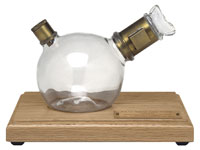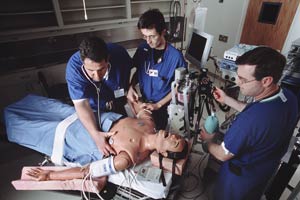Anesthesia Fact Sheet

In the Past - Prior to the 1840s, doctors and dentists did not routinely use anesthesia when operating on patients. Most doctors attempted surgery only when it was absolutely necessary to save a person’s life, and operations were largely limited to amputations and removal of external growths. Although alcohol, opium, or other botanicals sometimes helped alleviate the agony, most surgical patients remained conscious and endured excruciating pain.
 Replica of the inhaler used by William T. G. Morton in 1846 in the first public demonstration of surgery using ether. Replica of the inhaler used by William T. G. Morton in 1846 in the first public demonstration of surgery using ether.
Wood Library/Museum, Park Ridge, IL.
- The introduction of less flammable anesthetic gases made operating rooms safer, and the discovery of intravenous anesthetic agents such as sodium thiopental made it possible for surgeons to control the dose. But well into the 1950s, doctors still usually sedated their patients using some type of anesthetic gas and monitored them with nothing more sophisticated than a stethoscope. Dangerous side effects were common and included heart rhythm and breathing problems, lowered blood pressure, and nausea and vomiting.
- For many decades after anesthetics became a routine part of surgery, practically nothing was known about how they work. Virtually all scientists believed that anesthetics blocked nerve cell signaling by disrupting fatty molecules in the membranes that envelop cells. This theory, first put forward in the early 1900s, dominated research on anesthetics for much of the 20th century. Anesthetics are difficult to work with in the laboratory, and the lack of tools to study them at the molecular level contributed to this period of slow scientific progress.
Today - Every year, millions of Americans undergo surgery safely with general anesthesia, although some risks remain. Many of these procedures, which have improved the health, longevity, and quality of life of the U.S. population, would not have been possible without modern anesthetic techniques.
- Scientists have learned that general anesthesia consists of several components, including sedation, unconsciousness, immobility, analgesia (lack of pain), and amnesia (lack of memory). They have developed agents that can provide each of these elements separately, which enables anesthesiologists to tailor the regimen to each procedure and patient.
- Advances in cell biology, genetics, and molecular biology have transformed anesthesiology into an active area of research. Scientists have largely abandoned the idea that anesthetics work by acting on fatty molecules in cell membranes. The bulk of the evidence now supports the idea that the drugs target specific protein molecules embedded in nerve cell membranes and interfere with neurotransmission. Researchers now believe that each anesthetic acts on a different set of molecules to bring about its characteristic effects.
- New general anesthetics, both inhaled and intravenous, act quickly and disappear rapidly from the bloodstream, so patients can go home sooner after surgery. Side effects are less common and usually not as serious as they once were. Despite these improvements, general anesthetics are still among the most dangerous drugs used by doctors, particularly for elderly patients and those with certain chronic, systemic diseases, such as diabetes.
- The discovery that local and regional anesthetics can be used to block specific nerves has provided doctors with an alternative to general anesthesia for many procedures, especially minor ones. With local and regional anesthetics, patients can remain conscious and comfortable during surgery. But these anesthetics can have side effects, and delivering them to the right spot is sometimes difficult.
- Anesthesiologists have become leaders in the area of patient safety. Their training includes practice responding to emergency situations using computer-controlled mannequins called patient simulators.
 Anesthesiology students training with a patient simulator. Anesthesiology students training with a patient simulator.
Jeffrey Taekman.
- Anesthesiologists carefully monitor patients throughout surgery using electronic devices that continually display vital signs. Major advances in monitoring include the continuous measurement of blood pressure, blood oxygen levels, heart function, and respiratory patterns. These advances have dramatically improved the safety of general anesthesia and make it possible to operate on many patients who were previously considered too sick to undergo surgery.
- The role of the anesthesiologist has expanded beyond the operating room to include caring for patients during postoperative recovery. Anesthesiologists also provide anesthesia for nonsurgical procedures such as endoscopy and various cardiac interventions, as well as during labor and delivery. In addition, anesthesiologists are often called upon by other specialists for advice on how to manage pain.
Tomorrow As scientists learn more about the molecular mechanisms by which anesthetics cause their various effects, they will be able to design agents that are more targeted, more effective, and safer, with fewer side effects.
- Observations of the short- and long-term effects of anesthetics on subsets of the population, such as the elderly or cancer survivors, will reveal whether certain anesthetics are better than others for members of those groups. Research on how a person’s genetic makeup influences the way he or she responds to anesthetics will enable doctors to further tailor anesthesia to individual patients.
- Research will yield a better understanding of why surgery sometimes triggers life-threatening postoperative events such as heart attack, kidney failure and respiratory distress. This may allow anesthesiologists to preempt and better respond to these dangerous conditions.
- Scientists will gain a better understanding of the mechanisms that underlie pain and consciousness from knowledge of how anesthetics affect these physiological states. This could lead to new ways to alleviate pain and to new treatments for conditions associated with a decrease or loss of consciousness, such as epilepsy and coma. Studies of the mechanisms of anesthesia may also provide insights into the nature of consciousness itself.
NIGMS Programs Anesthesiology Research and Training
Content created December 2007
|
